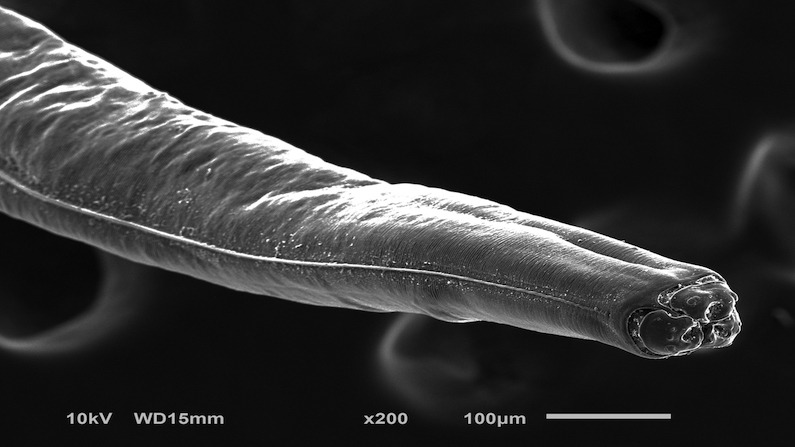
Diagnosing a rare human disease in Mexico’s lowlands
Diagnosing a rare human disease in Mexico’s lowlands

Scanning electron micrograph of the anterior part of Lagochilascaris minor.
PHOTO CREDIT: Manuel Elías-Gutiérrez

Coronal computerized tomography scan of the human patient. Arrow indicates destruction of the left mastoid bone.
PHOTO CREDIT: Hospital General de Chetumal, Mexico
References:
- de Moura MQ, Jeske S, Gallina T, Borsuk S, Berne MEA, Villela MM (2012) First report of Lagochilascaris (Nematoda: Ascarididae) eggs in a public park in Southern Brazil. Veterinary Parasitology 184(2-4): 359-361. https://doi.org/10.1016/j.vetpar.2011.09.019
- Prosser SW, Velarde-Aguilar MG, Leon-Regagnon V, Hebert PD (2013) Advancing nematode barcoding: A primer cocktail for the cytochrome c oxidase subunit I gene from vertebrate parasitic nematodes. Molecular Ecology Resources 13(6): 1108-1115. https://doi.org/10.1111/1755-0998.12082
Written by

David González-Solís
El Colegio de la Frontera Sur, Chetumal, México

Manuel Elías-Gutiérrez
El Colegio de la Frontera Sur, Chetumal, México
Jenny Alejandra Prado-Bernal
Clínica Carranza, Chetumal, México
Miguel Alfredo García-de la Cruz
Hospital General Dr. Manuel Gea González, Ciudad de México, México
doi: 10.21083/ibol.v9i1.5475
Don't Miss Out!
Subscribe to the iBOL Barcode Bulletin for updates on DNA barcoding efforts, the iBOL Consortium, and more.
comment on this article
The Barcode Bulletin moderates comments to promote an informed and courteous conversation. Abusive, profane, self-promotional, or incoherent comments will be rejected.
